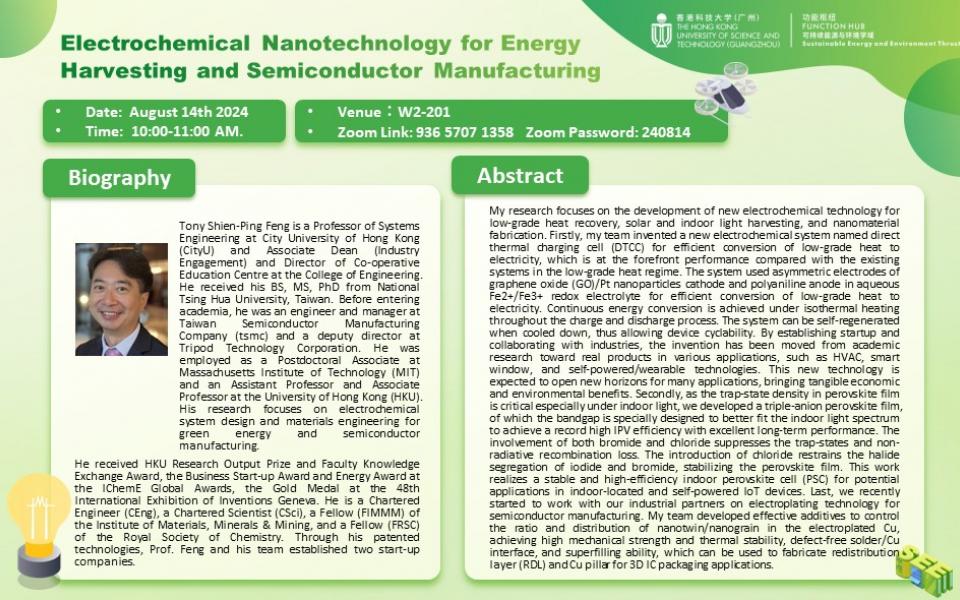Public Research Seminar by Sustainable Energy and Environment Thrust, HKUST(GZ) - Electrochemical Nanotechnology for Energy Harvesting and Semiconductor Manufacturing
My research focuses on the development of new electrochemical technology for low-grade heat recovery, solar and indoor light harvesting, and nanomaterial fabrication. Firstly, my team invented a new electrochemical system named direct thermal charging cell (DTCC) for efficient conversion of low-grade heat to electricity, which is at the forefront performance compared with the existing systems in the low-grade heat regime. The system used asymmetric electrodes of graphene oxide (GO)/Pt nanoparticles cathode and polyaniline anode in aqueous Fe2+/Fe3+ redox electrolyte for efficient conversion of low-grade heat to electricity. Continuous energy conversion is achieved under isothermal heating throughout the charge and discharge process. The system can be self-regenerated when cooled down, thus allowing device cyclability. By establishing startup and collaborating with industries, the invention has been moved from academic research toward real products in various applications, such as HVAC, smart window, and self-powered/wearable technologies. This new technology is expected to open new horizons for many applications, bringing tangible economic and environmental benefits. Secondly, as the trap-state density in perovskite film is critical especially under indoor light, we developed a triple-anion perovskite film, of which the bandgap is specially designed to better fit the indoor light spectrum to achieve a record high IPV efficiency with excellent long-term performance. The involvement of both bromide and chloride suppresses the trap-states and non-radiative recombination loss. The introduction of chloride restrains the halide segregation of iodide and bromide, stabilizing the perovskite film. This work realizes a stable and high-efficiency indoor perovskite cell (PSC) for potential applications in indoor-located and self-powered IoT devices. Last, we recently started to work with our industrial partners on electroplating technology for semiconductor manufacturing. My team developed effective additives to control the ratio and distribution of nanotwin/nanograin in the electroplated Cu, achieving high mechanical strength and thermal stability, defect-free solder/Cu interface, and superfilling ability, which can be used to fabricate redistribution layer (RDL) and Cu pillar for 3D IC packaging applications.
Tony Shien-Ping Feng is a Professor of Systems Engineering at City University of Hong Kong (CityU) and Associate Dean (Industry Engagement) and Director of Co-operative Education Centre at the College of Engineering. He received his BS, MS, PhD from National Tsing Hua University, Taiwan. Before entering academia, he was an engineer and manager at Taiwan Semiconductor Manufacturing Company (tsmc) and a deputy director at Tripod Technology Corporation. He was employed as a Postdoctoral Associate at Massachusetts Institute of Technology (MIT) and an Assistant Professor and Associate Professor at the University of Hong Kong (HKU). His research focuses on electrochemical system design and materials engineering for green energy and semiconductor manufacturing.
He received HKU Research Output Prize and Faculty Knowledge Exchange Award, the Business Start-up Award and Energy Award at the IChemE Global Awards, the Gold Medal at the 48th International Exhibition of Inventions Geneva. He is a Chartered Engineer (CEng), a Chartered Scientist (CSci), a Fellow (FIMMM) of the Institute of Materials, Minerals & Mining, and a Fellow (FRSC) of the Royal Society of Chemistry. Through his patented technologies, Prof. Feng and his team established two start-up companies.
For inquiries, please contact Miss Suggi WU (+86-20-88332966, suggilswu@hkust-gz.edu.cn)
